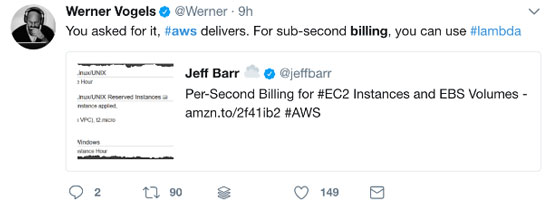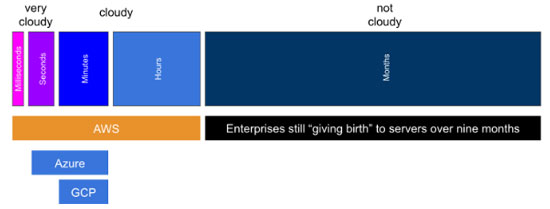How do you want your billing? Per hour? Per second? Per millisecond? Amazon Web Services (AWS) now has them all (see Figure 1).

Figure 1 — AWS launches per-second pricing.
From 2 October, you no longer need to pay the minimum hour tax if you are a reasonably sophisticated cloud user. The pricing applies to Amazon’s computing service, called EC2, and its Elastic Block Storage (EBS) storage service. The per-second pricing comes after a one-minute minimum. Also, it’s only for Linux virtual machines. It doesn’t apply for now to computing “instances” running Microsoft Windows or Linux distributions that have a separate hourly charge.
So, what is a reasonably sophisticated cloud user?
-
Someone using DevOps CI/CD pipelines that build up and tear down environments all day. If you cycle through this four times sequentially in an hour, you pay for four hours per instance, even if they only lived for a few minutes. Now you will only pay for one minute per instance plus the seconds that the instances are launched.
-
Someone using an auto-scaling group managing a fleet of small instances that elastically grow and shrink on demand. Shrink down to one tiny instance and then up to 30 across three availability zones. Imagine doing this a lot in a few hours, and all the minimum one-hour tax you will no longer incur.
-
Those with smaller and more variable, unpredictable workloads (startups, anyone?) felt they got more value on GCP or Azure with their per-minute billing, so this makes AWS more palatable to those many use cases.
The evolved cloud market billing landscape now looks like Figure 2.

Figure 2 — The evolved cloud market billing landscape.
Azure does offer per-second billing, but only for containers (plus a fee per instance). The AWS ECS (Container Service) was effectively per hour, as you paid for the underlying EC2, but now that playing field is level.
Google offers per-minute pricing with a minimum charge of ten minutes, so in effect they are now the ones looking more expensive than AWS.
Azure Functions are priced in per-execution seconds, unlike AWS Lambda, which is priced per-million requests plus durations in 100ms units.
Per-second billing won’t impact serverless/functions-as-a-service/event-driven computing such as AWS Lambda because they are quite different architectures and use cases. Running a function in an event-driven system is pretty far away from building and running whole virtual machines. It’s not something you can flip-flop between, but people are replacing virtual machines with serverless architectures.
How Will AWS Implement Per-Second Billing?
Don’t be expecting per-second prices on aws.amazon.com. Instead, AWS will pro rata the cost in its billing engine like this:
($hourly / 3600) x (60s min charge + your usage seconds above 60s)
Let’s look at an example. Assume you launch and terminate one EC2 instance four times in one hour:
-
Before 2 October, that will mean four hours billed, even though the actual usage was only 600 seconds. For a typical m4.large that would be $0.40.
-
After 2 October, for this simple example, it will be $0.02 (rounded up). That’s a savings of 95%.
-
Per-second billing = $cost of one hour / 3600 = $0.000028
-
600 x $sec = $0.0168
Figure 3 illustrates what your AWS bill might look like. [Note: it is still reported in instance hours but now with decimal point hours consumed.]

Figure 3 — A sample AWS bill.
What Is the Impact on AWS Consumers?
You will only benefit if you are reasonably sophisticated. If you are slow/inelastic/lazy/not bothered/old fashioned/not paying the bill and you don’t exploit cloud elasticity or “do DevOps,” then per-second billing will make no difference to your flat, flabby, static workloads and you will continue to pay a premium for your sloth. Harsh? Fact.
Why is AWS doing this? There are five good reasons:
-
Competition (Google Cloud and Azure per-minute billing — will they respond?)
-
Cost savings (AWS loves a price reduction!)
-
Elasticity (if you can do it)
-
Democratizing technology (everyone gets this, not just selected customers)
-
Pace of innovation (AWS is a release machine, though it’s still Day 1 at AWS!)
It’s the truly agile that will benefit — developers with their CI/CD pipelines building up and tearing down environments, and those that exploit auto-scaling groups. Could per-second billing finally get that enterprise girth into those slimline agile pants?
Who Performs Your Cloud Finance Manager Role?
This will highlight to customers something we’ve been advising clients to do for some time: make someone accountable for cloud finance. It’s not a full-time gig and you can add the role to an existing member of your cloud team (the leader or a project manager type who already works with budgets is a good idea).
This individual should be driving the team to be more efficient with their cloud usage, which is a minimum of:
-
Buying appropriate usage commitment, such as reserved instances or subscriptions from a cloud resource broker like Strategic Blue.
-
Ensuring consumption of commitments, using them, and not wasting them — and avoiding buying the wrong instance and compounding the mistake buying (again) on demand so you are paying twice!
-
Update the application architecture from the old-fashioned “two big VMs for HA” and instead having an elastic fleet of smaller instances integrated with auto-scaling groups.
-
Making cloud usage and cost transparent, and ensuring individuals like developers are accountable for their usage.
What Is the Impact on AWS Partners?
What does this mean for AWS partners that “do” cloud management and finance? There are three perspectives here:
-
The toolers
-
The managed service providers (MSPs)
-
The financiers
All three types of partner have just over eight days to adjust how they do things.
The toolers sell self-service capacity and billing software, and will need to modify their databases, engines, and UIs to cope with the change. The reasoning engines that make recommendations will need to change. Cloud management is already difficult to provide, buy, and use — what will adding more fine granularity data points do?
The MSPs manage multiple AWS customers and provide billing and additional management services.They will now have to update their own billing mechanisms to adapt to the AWS changes. MSPs often provide advisory services to customers, and it’s likely that they will see more customers wanting to be more agile, so there could be a boom in AWS services for MSPs and AWS consultants generally.
The financiers act as intermediaries to help organizations to buy cloud on their terms, such as six-month agreements instead of one- or three-year agreements; there might be some adjustment for forecasting models to ensure the finance matches usage. Usage might become more variable and elastic as customers become more sophisticated.
My work with Strategic Blue, which has its own internal tools and uniquely acts as an AWS MSP and cloud financier, will reveal the impact of this new pricing model in October, so expect an update in a few weeks’ time. Strategic Blue CEO and Cutter Senior Consultant James Mitchell has already started sharing his insights into the transparency impact of even more granular pricing.



